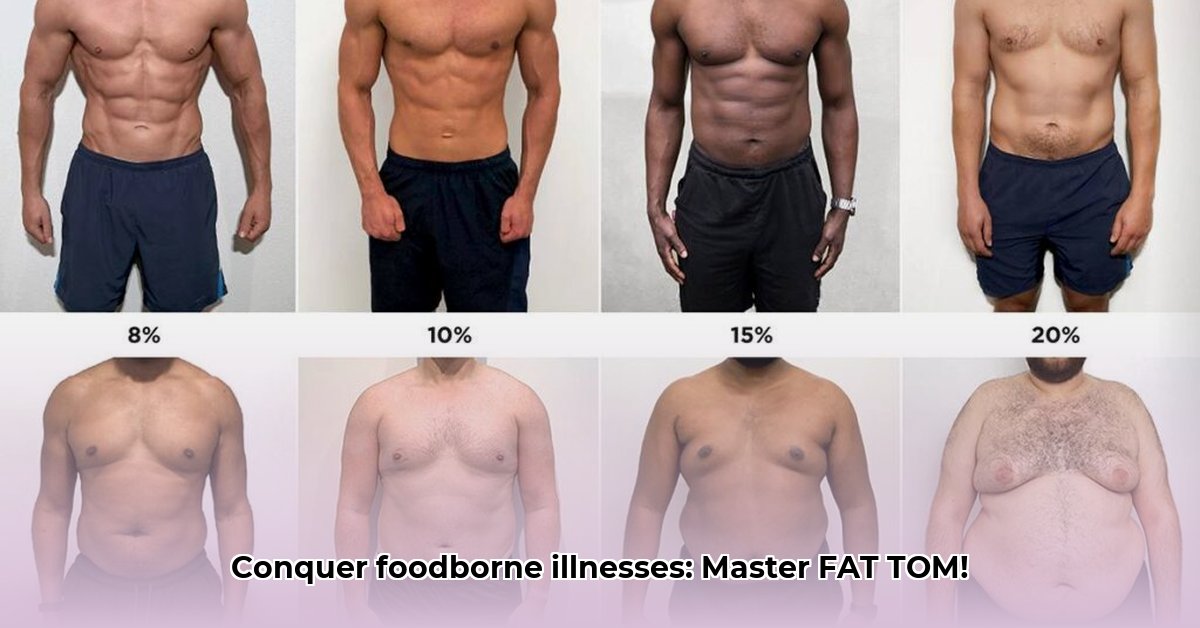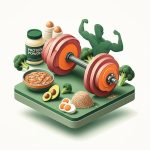Are you concerned about food poisoning? This comprehensive guide explains the essential FAT TOM principles, providing you with the knowledge to ensure food safety. Learn how to control temperature, time, and moisture effectively to prevent bacterial growth and protect your customers and your business.
Demystifying FAT TOM: The Key to Preventing Foodborne Illness
FAT TOM is a simple acronym that can significantly reduce the risk of foodborne illnesses. Think of it as your essential checklist in the kitchen – a memory tool that helps you understand the six key factors that influence bacterial growth: Food, Acidity, Time, Temperature, Oxygen, and Moisture. Controlling these factors is the foundation of a robust food safety strategy.
Understanding the Acronym: What Does FAT TOM Stand For?
FAT TOM represents the six critical conditions that support bacterial growth in food:
-
Food: Bacteria require nutrients to thrive, and high-protein foods like meat, poultry, eggs, dairy products, and seafood are particularly susceptible to contamination. These foods act as “bacterial magnets”, providing an ideal environment for microbial growth.
-
Acidity (pH): Bacteria prefer a neutral to slightly acidic environment. The pH scale measures acidity, with lower numbers indicating higher acidity. Acidic foods with a low pH naturally inhibit bacterial growth, extending shelf life.
-
Temperature: The “temperature danger zone” (TDZ) between 41°F (5°C) and 135°F (57°C) is where bacteria multiply rapidly. This range provides optimal conditions for bacterial growth, making temperature control critical.
-
Time: The longer food remains in the temperature danger zone, the more time bacteria have to multiply, increasing the risk of foodborne illness. Minimizing the time food spends in the TDZ is crucial for food safety.
-
Oxygen: Most harmful bacteria are aerobic, meaning they require oxygen to survive and grow. However, some bacteria, like Clostridium botulinum (botulism), thrive in the absence of oxygen (anaerobic).
-
Moisture (Water Activity): Bacteria need moisture to grow. Water activity (aw) measures the amount of unbound water available for microbial growth. Lowering the moisture content of food reduces its water activity, inhibiting bacterial growth and extending shelf life.
Mastering FAT TOM empowers you to proactively prevent foodborne illnesses, creating a safer environment for everyone.
Implementing FAT TOM: A Comprehensive Action Plan
Now that you understand the principles of FAT TOM, let’s explore practical strategies for controlling these factors and preventing bacterial growth:
-
Food – Selecting and Storing Wisely:
- Purchase high-quality ingredients: Choose fresh ingredients from reputable suppliers, ensuring they are free from visible signs of spoilage or contamination.
- Store food properly: Store raw meats, poultry, and seafood on the bottom shelf of the refrigerator to prevent cross-contamination. Use airtight containers to minimize exposure to air and moisture.
-
Acidity – Leveraging Natural Barriers:
- Utilize acidic ingredients: Incorporate acidic ingredients like lemon juice, vinegar, or marinades to inhibit bacterial growth and enhance flavor.
- Employ preservation methods: Utilize preservation methods like pickling, fermentation, and canning to leverage acidity for long-term food storage and safety.
-
Temperature – Maintaining Safe Zones:
- Refrigerate promptly: Refrigerate perishable foods below 41°F (5°C) within two hours of purchasing or preparing them to slow bacterial growth.
- Cook thoroughly: Use a food thermometer to ensure food reaches the recommended internal temperature, killing harmful bacteria.
- Hot hold safely: Keep hot foods hot (above 135°F/57°C) using chafing dishes, warming trays, or other appropriate equipment to prevent bacterial growth.
- Cool rapidly: Cool cooked food rapidly to below 41°F (5°C) within six hours, using shallow containers, ice baths, or blast chillers to minimize time in the temperature danger zone.
- Avoid the two-hour rule: Never leave food in the temperature danger zone for more than two hours, especially during events like picnics or buffets.
-
Time – Acting Swiftly:
- Minimize time in the TDZ: Keep track of how long food spends in the temperature danger zone, discarding any food that has been in the TDZ for more than two hours.
- Serve promptly: Serve food immediately after cooking to minimize the time it spends at room temperature.
- Store leftovers immediately: Store leftovers in the refrigerator or freezer as soon as possible to prevent bacterial growth.
-
Oxygen – Controlling the Atmosphere:
- Use airtight containers: Store food in airtight containers to limit exposure to oxygen and prevent aerobic bacterial growth.
- Vacuum sealing: Consider vacuum sealing food to remove oxygen, extending shelf life and inhibiting bacterial growth.
- Modified Atmosphere Packaging (MAP): Explore modified atmosphere packaging (MAP), which controls the gases surrounding the food to inhibit microbial growth.
-
Moisture – Reducing Water Activity:
- Dry foods properly: Properly dry foods like herbs, fruits, and vegetables to reduce moisture content and inhibit bacterial growth.
- Use preservation techniques: Utilize preservation techniques like canning, drying, and smoking to lower water activity and extend shelf life.
- Store dry foods correctly: Store dry foods in airtight containers in a cool, dry place to prevent moisture absorption.
Applying FAT TOM: Real-World Applications
FAT TOM principles are applicable in various settings, from professional kitchens to home cooking:
- Restaurants: Implement strict temperature controls, sanitation procedures, and staff training to ensure customer safety and prevent foodborne illnesses.
- Home cooks: Practice proper refrigeration, avoid cross-contamination, and cook food to the correct temperature to protect yourself and your family.
- Food manufacturers: Utilize sophisticated equipment and processes to control FAT TOM factors, ensuring food safety on a large scale.
By consistently applying FAT TOM principles, you create a strong foundation for food safety, building confidence in your ability to provide safe, delicious food.
Mastering FAT TOM: Optimizing Food Preservation Methods
Key Takeaways:
- Understanding FAT TOM is essential for safe and effective food preservation, minimizing microbial growth and preventing spoilage and foodborne illnesses.
- The effectiveness of controlling FAT TOM factors depends on the food’s characteristics and the chosen preservation technique.
Understanding FAT TOM Principles
FAT TOM represents the six key environmental factors that influence microbial growth in food. Mastering these factors is essential for preserving food safely, whether at home or in an industrial setting.
-
Food: High-protein foods are more susceptible to bacterial growth than low-protein foods.
-
Acidity (pH): Bacteria thrive in neutral or slightly acidic environments. Highly acidic foods naturally inhibit bacterial growth.
-
Temperature: The temperature danger zone (TDZ) is where bacteria multiply rapidly.
-
Time: The longer food remains within the TDZ, the greater the risk of bacterial growth.
-
Oxygen: Many bacteria need oxygen to survive (aerobic). Removing oxygen limits their growth.
-
Moisture (Water Activity): Bacteria require moisture to grow. Reducing water activity inhibits bacterial growth significantly.
Applying FAT TOM Principles to Different Food Preservation Methods
Understanding how to apply FAT TOM principles to different food preservation methods is key to ensuring food safety and extending shelf life. Let’s explore several common methods:
-
Refrigeration:
- Temperature: Lowers temperature, slowing bacterial growth.
- Considerations: Requires careful monitoring of temperature and humidity to maintain optimal conditions.
-
Freezing:
- Moisture: Lowers water activity, halting bacterial growth.
- Considerations: Thawing requires careful monitoring of time and temperature to prevent bacterial growth.
-
Canning:
- Temperature: Uses heat to destroy harmful bacteria.
- Oxygen: Creates a vacuum seal, preventing oxygen exposure.
- Considerations: Requires careful adherence to established canning procedures to prevent botulism.
-
Dehydration:
- Moisture: Lowers water activity, inhibiting bacterial growth.
- Considerations: Requires proper drying techniques to prevent contamination and ensure consistent moisture removal.
-
Vacuum Sealing:
- Oxygen: Removes oxygen, inhibiting aerobic bacterial growth.
- Considerations: Best used in conjunction with other preservation methods, such as refrigeration or freezing.
-
Fermentation:
- Acidity: Uses beneficial bacteria to produce acids that lower pH, enhancing food safety.
- Considerations: Requires careful control of temperature and salinity to ensure successful fermentation.
Optimizing Your Approach
To effectively apply FAT TOM principles to different food preservation methods, consider these points:
- Identify your food’s characteristics: Understand the specific properties of the food you are preserving.
- Choose the appropriate preservation method: Select a method that effectively controls the relevant FAT TOM factors.
- Monitor and adjust factors: Continuously monitor temperature, humidity, and other factors to ensure optimal preservation.
Even with effective preservation methods, proper hygiene and handling are essential for food safety. Food preservation is about minimizing risk and ensuring the safety and quality of your food.
FAT TOM Principles
- Gluten Free Meal Prep Ideas for Delicious, Hassle-Free Eating - November 28, 2025
- Gluten Free Meal Prep for Stress-Free and Healthy Eating - November 27, 2025
- Quick And Easy Chicken Thigh Meal Prep For Weight Loss - November 26, 2025










